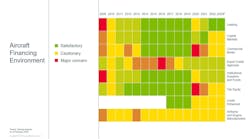June 22--If Wichita is to remain a key aviation cluster for years to come, it must continue to innovate, globalize, and train and keep talent.
Those are the same issues facing the United States aviation industry if it is to maintain its global leadership, according to a study by PricewaterhouseCoopers, or PwC.
Wichita is one of four major successful aviation clusters in the U.S., along with Fort Worth-Arlington, Texas, the Seattle and Everett, Wash., area and Connecticut, according to the study -- called "Aviation's second golden age: Can the U.S. aircraft industry maintain leadership?" Clusters are emerging in South Carolina, Oklahoma and Ohio.
Growth isn't limited to those clusters, however, the study said. Suppliers are spreading across the U.S. and to Mexico.
Rolland Vincent, an aviation consultant with Rolland Vincent Associates, said he thinks Wichita will remain a key aviation cluster, despite the departure of Boeing, the consolidation of Cessna and Beechcraft and recent layoffs at Bombardier Learjet.
"It ebbs and flows," Vincent said. "Markets come and go, and other cities want what Wichita has. ... You only have a few cities that even hope to compete."
Wichita's aviation industry is two-fold: commercial aerospace and general aviation.
In general aviation, "the good news is that Textron Aviation, which includes Cessna and Beechcraft, has over half of the world's turbine fleet. That doesn't count the Learjet fleet out there. That's an amazing supply of parts and customers," Vincent said. "There's so much activity there."
The brands are strong.
"People don't walk away from these companies or these brands easily," he said. "Most customers are conservative. They don't buy very often so they stock to what they know. They know Cessna. They know Learjets."
It's up to the Wichita companies to develop products customers want, however, he said.
Surveys done by Vincent ask about their buying intentions.
They show that the middle of the business jet market, everything from the Citation Latitude to Bombardier's Challenger 350, is what they say they plan to buy, he said.
Teal Group aerospace analyst Richard Aboulafia said there is some risk to Wichita's cluster.
"It's a combination of unfortunate developments, but none of them speak to Wichita's competitiveness," Aboulafia said. "Having heavy exposure to the bottom half of the business jet market, that's just the wrong place to be. But still, that's more of an accident of history than the result of workforce skills or anything like that."
That won't be an issue if the small- and mid-size business jet market recovers in a couple of years, he said.
Cessna is investing in the future, even it has stumbled in the past, he said. And Beechcraft's acquisition by Cessna's parent company, Textron, has stabilized the company.
"Everything in the world of aircraft is doing just fine, except for the bottom half of the business jet market," he said.
While much of the aviation market has recovered, Wichita also is being hit by the loss of Boeing, which is closing its Wichita defense facility and moving the programs elsewhere.
Aboulafia pointed out that it's not just Wichita being hit by changes in Boeing's defense business.
Boeing is winding down production of the C-17 large military transport aircraft at its plant in Southern California. And without new orders, Boeing's F-15 Strike Eagles and its FA-18 Super Hornet assembly lines in St. Louis are at risk in the coming years as well.
"There are bigger changes happening," in the industry, Aboulafia said. "If you're on the wrong side of those changes, nothing can be done."
The health of commercial aviation is key to Wichita, which Spirit AeroSystems and other suppliers rely on for work.
Order backlogs for commercial jets are unprecedented. Spirit, for example, is gearing up to take on increased production.
"By some measures, it seems the industry is entering a second golden age," the report said.
But it also noted risks.
Emerging foreign competitors are increasing their capabilities and technical prowess in their home markets, the study said.
That may alter the industry's competitive landscape in the U.S. through this decade and beyond, it said.
Industry leaders say that three issues most prevalent for the future include talent shortfalls, accelerating innovation across a complex supply and production chain, and globalization pressures, it said.
Boeing forecasts that demand for new commercial airplanes will total 35,280 in the 20-year period ending 2032, an average of more than 1,700 planes a year.
Besides Boeing and Airbus, planemakers in China, Canada, Brazil, Russia and Japan are planning to compete in the market.
But whether emerging competitors will be able to reach their long-term goals remains unanswered, the study said.
Much of the engineering work is still in the U.S., John Tomblin, Wichita State University's National Institute for Aviation Research executive director, told PwC.
Mexico and China are already making components, he said.
"They will get the engineering prowess and, when they do, they will stand up -- not only in commercial aviation, but in military aircraft," Tomblin said in the study.
The aerospace customer base has been globalizing for a long time, said Scott Thompson, a partner and U.S. aerospace and defense leader with PwC.
"Right now it's particularly apparent," Thompson said. "When you look at aircraft sales, so much of it is driven by the Middle East and Asia. But the other part of globalization is the competition."
Innovation
Innovation in production materials and automation -- involving, say, robots and 3-D printing -- are the future, Tomblin told The Eagle.
So is the use of new, advanced materials, such as composites, titanium, and aluminum and lithium alloys.
"The age of the aluminum aircraft is ending," Tomblin said.
Increasingly, more companies are using advanced materials, such in the Boeing composite 787 Dreamliner and Bombardier's Learjet 85.
"It's definitely where the future is heading," Tomblin said.
Is Wichita ready for the change?
"We have all the right pieces in place here in Wichita," Tomblin said. "We have the research environment and we have the workforce environment. ... If someone wanted to put these advanced technologies (to use), we can do it. We can train a workforce and we can get it into the production line."
The biggest changes will take place when planemakers add new models and incorporate new technologies, whether the planes are manned or unmanned, Tomblin said.
"That's where we help," he said.
Innovations could mean less work done abroad, he said, but they also could mean fewer workers.
The PwC report notes that automation can reduce costs and employee injuries and increase productivity.
Spirit AeroSystems, for example, uses robots on some of its production lines.
One potential game changer is price-stable, renewable biofuels, the study said.
Estimates on the extent to which biofuels will replace jet fuel by 2035 range widely, from 40 percent to 70 percent, it said.
The aviation industry is stepping up to help develop biofuels.
Boeing, Airbus and Embraer set a goal of having biofuels account for 4 percent of the aviation industry's fuel demand by 2020, the study said.
As the technology becomes more sophisticated, so do the planes -- including their communications and avionics systems.
Boeing's 787 Dreamliner, for example, requires 6.5 million lines of software code to run its avionics and onboard support systems alone, the study said.
Digitalizing airplanes will require the industry to recruit specialists such as computer and electronic engineers and designers and those with specialized skills to make the systems secure and maintained, it said.
"That requires a while different type of worker," said Tony Kinkel, president of the Wichita Area Technical College.
Workforce talent
Wichita's aviation workforce has a solid reputation.
"I'm a big believer in the talent base that's in Wichita," Vincent said. "The challenge is the aging of the talent base."
The industry is not attracting young people the way it should, he said.
For example, "it used be a glamorous job to be an airline pilot," he said. "Not so much anymore."
And the pipeline for engineers isn't filling up the way it used to, he said.
"Enticing people to get into the industry is vital," Vincent said.
The rapid global growth of aviation raises the question of whether the industry might outstrip the availability of talent needed to support it, the study said.
Boeing forecasts that the global aviation industry will need 600,000 new airline maintenance technicians by 2031. The U.S. will need 20,000 aerospace engineers from 2010 to 2020, one report says.
And there will be a growing need for avionics technicians, industrial machinery mechanics and aircraft structure and systems assemblers, it said.
Students were once drawn to aviation from what's been called the "Apollo effect" from the allure and excitement around Apollo missions and NASA achievements, the study said.
"Is there something that's the spark for kids today?" Kinkel said, answering that technology, robotics and the rise of personal devices may provide that spark.
Some question why there is such a push to train aviation workers, given the loss of aviation jobs in the city.
While Kinkel understands the skepticism, he said long-term, impending massive retirements in Wichita's workforce will create demand.
Nationally, estimates say more than 20 percent of the aviation and defense industry workforce will be eligible for retirement by 2020.
That figure is much higher in Wichita, Kinkel said. "Long-term, there's a tremendous opportunity in aviation jobs."
Without a supply of workers, companies will be forced to pay more for available talent, which raises their costs, he said. They means they could go to states that are training a workforce and where shortages don't exist.
"For the first time ever, the need for a trained workforce is eclipsing other concerns in the industry on where to locate," he said.
While touting WATC's training programs and state initiatives that encourage high school students to enroll in technical and vocational classes, Kinkel said he's concerned.
The Legislature this year cut some of the funding for the WATC-affiliated National Center for Aviation Training, he said, which meant less equipment. Also, he said, fewer federal funds are available through grants and other programs to help students pay for their education.
"We're losing enrollment based on those changes," he said.
Reach Molly McMillin at 316-269-6708 or [email protected]. Follow her on Twitter: @mmcmillin.
Copyright 2014 - The Wichita Eagle

